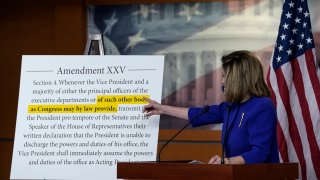
On Thursday officials including House Speaker Nancy Pelosi, Senate Democratic Leader Chuck Schumer and Republican Rep. Adam Kinzinger called for the invocation of the 25th Amendment, Section 4, to remove President Donald Trump from office before his term ends on Jan. 20. It comes in the wake of the deadly pro-Trump riot on Wednesday in Washington, D.C.
So what is the 25th Amendment and its Section 4 provision? Here is information about the amendment and whether Section 4 could be used against Trump in this situation.
What is the 25th Amendment?
The 25th Amendment was passed by Congress on July 6, 1965, and ratified on Feb. 10, 1967. The amendment has four sections that provide avenues by which a sitting U.S. president may be removed (temporarily or permanently) from the helm of the government, if the president is not able (physically or mentally) to perform the duties of the office.
Has it been used before?
The 25th Amendment has been used multiple times over the years, according to Richard Kay, an expert on constitutional law and a Wallace Stevens Professor of Law Emeritus at the University of Connecticut.
Money Report
Most recently, it was used in 2007 when then-President George W. Bush appointed his Vice President Dick Cheney as acting president for the time period Bush was under general anesthesia during a colonoscopy. In that instance, Section 3 was used, which allows the president to willingly discharge his powers.
However, Section 4 has never been used.
Why section 4 this time?
For the 25th Amendment, what "the drafters had in mind was the president being in some way physically disabled," Kay tells CNBC Make It. "But they throw this one at the end (Section 4), which clearly contemplates some kind of situation where the powers that be think the president is incapable of going on and the president disagrees," he says.
It comes into play when the vice president and certain other officials declare that the president is "unable to discharge the powers and duties of his office," the section says, but does not require the president's cooperation.
"It's a way in which people who work with the president and are convinced that the president cannot effectively carry out his functions, are able to at least temporarily displace him and get the vice president to take over," Kay says.
What's the process?
The most important factor needed to use the 25th Amendment is having the vice president and a majority of the cabinet on board, says Kay.
"If the vice president and a majority of the cabinet send a letter to the speaker of the house and the president pro tempore of the Senate saying that, in their opinion, the president is incapable of carrying out of his functions and duties...instantly, the president ceases to have authority and the vice president takes over," Kay says.
However, should that happen, the president can immediately follow up with his own letter to congressional leaders saying that he is indeed capable of carrying out his responsibilities.
"At that point, the president is back in charge," Kay says.
The vice president and cabinet officers could then send a final letter to Congress disputing the president's claim and restating that the president is unable to do to job, Kay says.
After that, according to the Constitution, it's up to the houses of Congress to decide and vote on the matter, and they have up to 21 days to do so, Kay says. During the voting process in Congress, the vice president would be in charge.
While the process sounds complicated, "these communications can go lickity split in a situation like this," Kay says.
Displacing the president would require an affirmative vote of two-thirds of the members of each House.
Will this actually happen?
The 25th Amendment, has "never been used for something like this," says Kay. "Section 4 is only about cases where there's a disagreement," Kay says. "It's contentious." It's also a political matter, he says.
Kay believes the chances of it happening are "50/50." "The key person is the vice president," Kay says. "No vice president on board, nothing is going to happen."
The White House did not immediately respond to CNBC Make It's request for comment.
Don't miss:
The best credit cards for building credit of 2021
From growing up in poverty to battling the Covid pandemic: How Northwell Health’s CEO found success






